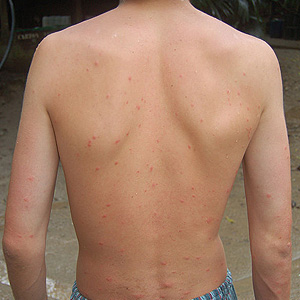Bed Bug Information
Bed Bugs (Cimexlectularius) are small, wingless insects showing all of the characteristics needed to be viewed as a “true” bug. A determined human parasite throughout history, the extensive use of insecticides after World War II led to a visible drop, and near-total elimination, in bed bug populations in most industrialized countries. Almost non-existent in Canada by the early 1990s, the Bed Bug has proven very tough with its sudden and profound comeback. The real cause of the Bed Bug return is highly debated. However, most scientists agree that it’s due to multiple factors. The continuous discontinuance of pesticides by regulatory authorities has restricted the use of highly effective products. Combined with the dramatic rise in global travel, Bed Bugs have been set to return in force.
Bed Bug Biology
As mentioned above, Bed Bugs are considered a “True Bug” possessing all of the characteristics needed…3 body segments, six legs, sucking-piercing mouths, and continuous metamorphosis. Bed Bugs have five nymphal stages and need to feed at least once to develop to the next stage, shedding between feedings, in a transition to reproductive maturity. Adults feed 3 to 5 days during their estimated 6 to 12-month lifespan but in certain circumstances, can survive up to a year without feeding. Adult Bed Bugs are around 1/4-inch in length, oval-shaped, flat and reddish-brown. They give off a characteristic musty, sweet odour similar to raspberries or coriander. They regularly defecate while feeding, leaving signs of infestation (rusty or tarry spots) on beddings and in resting places. Pea-sized white clusters of 200 to 500 eggs may also be visible in larger populations. Bed Bugs favour warm temperatures in-between 83°F to 90°F but can survive in more wide ranges. Bed Bugs like high humidity environments, as well.
Blood…It’s what’s for dinner!
 Bed Bugs feed on human blood and like to feast at night when their prey is unconscious. Like mosquitoes, Bed Bugs penetrate the skin and inject an anesthetic so they can feed peacefully, sucking on blood for 5 to 10 minutes. Itching may occur once the host has awoken, and any remaining anesthetic has worn out. Although rare, these proteins may cause an allergic skin reaction. Bed Bug bites can raise ugly red welts as in the image to the left, but some people will not have a reaction to bed bug bites and will not get the nasty red sores. Bed Bug bites produce a round, raised, reddish welt and may itch intensely for several days. Bed Bug bites produce a round, raised, reddish bumps and may itch intensely for several days. Less than half of those bitten react, and since bed bug bites resemble those of other blood-feeding parasites such as mosquitoes and fleas, a completely accurate diagnosis is difficult. The presence of welts or raised sores is not a sure indicator that you have Bed Bugs, you must look for an actual Bed Bug to confirm an infestation. It is also essential to mention that here.
Bed Bugs feed on human blood and like to feast at night when their prey is unconscious. Like mosquitoes, Bed Bugs penetrate the skin and inject an anesthetic so they can feed peacefully, sucking on blood for 5 to 10 minutes. Itching may occur once the host has awoken, and any remaining anesthetic has worn out. Although rare, these proteins may cause an allergic skin reaction. Bed Bug bites can raise ugly red welts as in the image to the left, but some people will not have a reaction to bed bug bites and will not get the nasty red sores. Bed Bug bites produce a round, raised, reddish welt and may itch intensely for several days. Bed Bug bites produce a round, raised, reddish bumps and may itch intensely for several days. Less than half of those bitten react, and since bed bug bites resemble those of other blood-feeding parasites such as mosquitoes and fleas, a completely accurate diagnosis is difficult. The presence of welts or raised sores is not a sure indicator that you have Bed Bugs, you must look for an actual Bed Bug to confirm an infestation. It is also essential to mention that here.
Do You Have a Bed Bug Problem?
Bites, odour and voiding smears are tell-tell signs of a bed bug problem. But if you do not react to their bites, they may go undetected until your home becomes infested. Bed Bugs are easily confused with other pests like carpet beetles, bird and rodent mites, shiny spider beetles, parasitic wasps, even lint by the more paranoid few, making a diagnosis of an infestation best left to the experts at Peachtree Pest Control.
